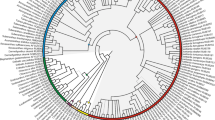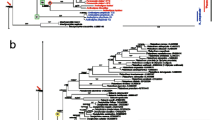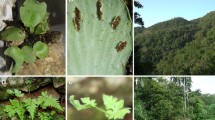Abstract
The monospecific fern genus Nephopteris is restricted to four páramos in Colombia. Until now, its phylogenetic relationships have not been clarified, although morphological traits suggest that it belongs to the taenitidoid clade of the subfamily Pteridoideae in the Pteridaceae. We isolated four chloroplast (atpA, chlL, rbcL, and rps4) loci of N. maxonii and performed maximum parsimony and maximum likelihood phylogenetic analyses, including a preliminary analysis based on rbcL of 424 accessions of leptosporangiate ferns. Then, we carried out separate and combined reconstructions for all four loci, focusing the sampling in the subfamily Pteridoideae (Pteridaceae). Our results show that Nephopteris belongs to the taenitidoid clade of the subfamily Pteridoideae and is nested in Jamesonia. Thus, the new combination Jamesonia maxonii is provided. Its dimorphic sterile and fertile leaves appear to be unique within the taenitidoids. Given that this species shares the same microhabitat with other Jamesonia species, it is unlikely that leaf shape evolution within the entire clade is a result of adaptive processes to páramo conditions.
Resumen
El género monoespecífico de helechos Nephopteris está restringido a cuatro páramos de Colombia. Hasta ahora, las relaciones filogenéticas del género no han sido precisadas, aunque los caracteres morfológicos sugieren que pertenece a la subfamilia Pteridoideae, de las Pteridaceae. Cuatro loci del cloroplasto (atpA, chlL, rbcL, and rps4) de N. maxonii fueron aislados y empleados para reconstruir la filogenia bajo Parsimonia y Máxima Verosimilitud, incluído un análisis preliminar basado en secuencias de rbcL de 424 muestras de helechos leptosporangiados. Enseguida, llevamos a cabo análisis separados para los cuatro loci, enfocando el muestreo en la subfamilia Pteridoideae (Pteridaceae). Nuestros resultados demuestran que Nephopteris pertenece al clado taenitidoide de la subfamilia Pteridoideae, anidado dentro de Jamesonia. Por lo tanto, proponemos la nueva combinación, Jamesonia maxonii. Las hojas dimórficas de J. maxonii son únicas dentro del clado de helechos taenitidoides. Debido a que esta especie crece en los mismos microhabitat junto a otras especies de Jamesonia, es improbable que la evolución foliar en el clado Jamesonia sea el resultado de procesos adaptativos frente a condiciones de páramo.




Similar content being viewed by others
Literature Cited
Akaike, H. 1974. A new look at the statistical model identification. IEEE Transactions on Automatic Control 19: 716–723. doi: 10.1109/TAC.1974.1100705.
Christenhusz, M. J. M., X-C. Zhang & H. Schneider. 2011. A linear sequence of extant families and genera of lycophytes and ferns. Phytotaxa 19: 7–54.
Cochran, A. T., J. Prado & E. Schuettpelz. 2014. Tryonia, a new taenitidoid fern genus segregated from Jamesonia and Eriosorus (Pteridaceae). PhytoKeys 35: 23–43. doi: 10.3897/phytokeys.35.6886
Gabriel y Galán, J. M., G. Migliaro & R. Lahoz-Beltrá. 2011. Effect of temperature and dark pretreatment on the germination of three species of Jamesonia (Pteridaceae, Polypodiopsida). Plant Species Biology 26: 254–258. DOI:10.1111/j.1442-1984.2011.00327.x
Goloboff, P. A., J. S. Farris & K. C. Nixon. 2008. TNT, a free program for phylogenetic analysis. Cladistics 24: 774–786.
González, F., R. Callejas-Posada & N. Pabón-Mora. 2014. Rediscovery and conservation status of the “cloud fern,” Nephopteris maxonii (Pteridaceae), with notes on its anatomical traits. Brittonia 67: 59–67. DOI 10.1007/s12228-014-9359-8
Hagemann, W. 1984. Morphological aspects of leaf development in ferns and angiosperms. Pp. 301–349. In: R. A. White & W. C. Dickison (eds.), Contemporary Problems in Plant Anatomy. Academic Press, Orlando.
Katoh, K., K. Misawa, K. Kuma & T. Miyata. 2002. MAFFT: a novel method for rapid multiple sequence alignment based on a fast fourier transform. Nucleic Acids Research 30: 3059–3066.
Lellinger, D. B. 1966. Nephopteris, a new genus of ferns from Colombia. American Fern Journal 56: 180–182.
Maddison, W. P. & D. R. Maddison. 2008. Mesquite: a modular system for evolutionary analysis. Version 2.5 http://mesquiteproject.org
Miller, M. A., H. T. Holder, R. Vos, P. E. Midford, T. Liebowitz, L. Chan, P. Hoover & T. Warnow. 2009. The CIPRES portals URL http://www.phylo.org
Nakazato, T. & G. Gastony. 2003. Molecular phylogenetics of Anogramma species and related genera (Pteridaceae: Taenitiodoideae). Systematic Botany 28: 490–502. doi:10.1043/02-40.1
Nixon, K. C. 2002. WinClada ver. 1.00.08. Published by the author, Ithaca, NY.
Posada, D & K. A. Crandall. 1998. MODELTEST: Testing the model of DNA substitution. Bioinformatics 14: 817–818.
Prado, J., C. D. N. Rodrigues, A. Salatino & M. L. F. Salatino. 2007. Phylogenetic relationships among Pteridaceae, including Brazilian species, inferred from rbcL sequences. Taxon 56: 355–368.
Sánchez-Baracaldo, P. 2004a. Phylogenetics and biogeography of the neotropical fern genera Jamesonia and Eriosorus (Pteridaceae). American Journal of Botany 91: 274–284. doi: 10.3732/ajb.91.2.274
———. 2004b. Phylogenetic relationships of the subfamily Taenitidoideae, Pteridaceae. American Fern Journal 94: 126–142.
——— & G. H. Thomas. 2014. Adaptation and convergent evolution within the Jamesonia-Eriosorus complex in high-elevation biodiverse Andean hotspots. PLoS ONE 9 (10): e110618. doi:10.1371/journal.pone.0110618.
Schuettpelz, E. & K. M. Pryer. 2007. Fern phylogeny inferred from 400 leptosporangiate species and three plastid genes. Taxon 56: 1037–1050. doi: 10.2307/25065903.
———, H. Schneider, L. Huiet, M. D. Windham & K. M. Pryer. 2007. A molecular phylogeny of the fern family Pteridaceae: Assessing overall relationships and the affinities of previously unsampled genera. Molecular Phylogenetics and Evolution 44: 1172–1185. doi: 10.1016/j.ympev.2007.04.011
Stamatakis, A., P. Hoover & J. Rougemont. 2008. A fast bootstrapping algorithm for the RAxML web-servers.Systematic Biology 57: 758–771. doi: 10.1080/10635150802429642
Tryon, A. F. 1962. A monograph of the fern genus Jamesonia. Contribution from the Gray Herbarium Harvard University 191: 109–203.
Tryon, R. M. 1964. Evolution in the leaf of living ferns. Bulletin of the Torrey Botanical Club 21: 73–85.
——— & A. F. Tryon. 1982. Ferns and allied plants, with special reference to tropical America. Springer-Verlag, Berlin.
———, A. F. Tryon & K. U. Kramer. 1990. Pteridaceae. Pp. 230–256. In: K. U. Kramer & P. S. Green (eds.), Pteridophytes and Gymnosperms. The Families and Genera of Vascular Plants. Springer-Verlag, Berlin.
Zhang, L., C. J. Rothfels, A. Ebihara, E. Schuettpelz, T. Le Péchon, P. Kamau, H. He, X.-M. Zhou, J. Prado, A. Field, G. Yatskievych, X.-F. Gao & L.-B. Zhang. 2014. A global plastid phylogeny of the brake fern genus Pteris (Pteridaceae) and related genera in the Pteridoideae. Cladistics, doi: 10.1111/cla.12094.
Acknowledgments
The authors thank R. Callejas-Posada and V. Suaza-Gaviria (Universidad de Antioquia) for field assistance, and J. F. Alzate (Centro de Secuenciación Genómica Nacional, Universidad de Antioquia) for lab assistance. We also thank the important commentaries on the manuscript made by L. M. Kelly and R. C. Moran (New York Botanical Garden) and two anonymous reviewers. This work was partially supported by the Convocatoria Programáticas Ciencias Exactas y Naturales 2012-2013 and by the Estrategia de Sostenibilidad 2013–2014 granted by the Comité para el Desarrollo de la Investigación (CODI), Universidad de Antioquia (Medellín-Colombia).
Author information
Authors and Affiliations
Corresponding author
Rights and permissions
About this article
Cite this article
Pabón-Mora, N., González, F. Nephopteris out of the clouds: Molecular evidence places the enigmatic N. maxonii (Pteridaceae) within the Jamesonia clade. Brittonia 68, 83–92 (2016). https://doi.org/10.1007/s12228-015-9394-0
Published:
Issue Date:
DOI: https://doi.org/10.1007/s12228-015-9394-0




